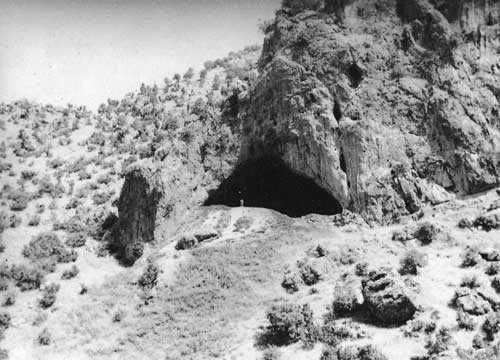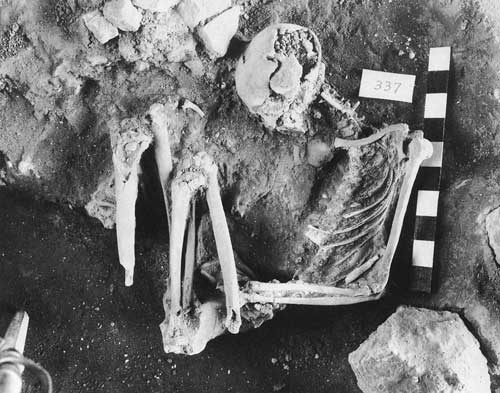
This Article From Issue
May-June 2005
Volume 93, Number 3
DOI: 10.1511/2005.53.0
The Proto-Neolithic Cemetery in Shanidar Cave. Ralph S. Solecki, Rose L. Solecki and Anagnostis P. Agelarakis. xvi + 234 pp. Texas A&M University Press, 2004. $50.
During the Neolithic Age, which began about 11,000 years ago, the prehistoric economies of our hunter-gatherer forebears changed to include domesticated plants and animals—a shift that revamped subsistence strategies, inspired technological developments, ended hunting and gathering in many places, altered patterns of settlement and rearranged social organizations. These transformations amounted to what archaeologist V. Gordon Childe in 1936 termed a "Neolithic Revolution," which profoundly affected human life and made us who we are today.
Archaeological evidence indicates that agriculture developed earliest in the Near East, specifically in the Zagros, Taurus and Pontic Mountains of Iraq, Iran and Turkey, and on the eastern coast of the Mediterranean, the Levant. Most of our archaeological knowledge of the period during which the transition from hunting and gathering to food production took place comes from the Levant. Far less is known about the Zagros Mountains.

From The Proto-Neolithic Cemetery in Shanidar Cave.
Thus the discovery in 1951 of Shanidar Cave in the Baradost Mountains, one of the western folds of the Zagros, 400 kilometers north of Baghdad in northeast Kurdistan, Iraq, gave a new geographic perspective on the very early Neolithic period. Excavations of the cave over the next decade yielded cultural data as well as skeletal remains of Middle Paleolithic Neandertals and Proto-Neolithic modern humans, representing two periods well-known for the scarcity of such material. The last excavation, in 1960, uncovered an undisturbed cemetery dating to around 10,600 years ago. Then investigations in the region had to stop because of unrest, although studies of the skeletal finds continued at the Iraq Antiquities Museum in Baghdad, where they had been shipped. Fortunately, the human osteological material from Shanidar Cave was spared when the museum was looted in 2003.
Now Ralph S. Solecki (who discovered the cave and led the excavations), Rose L. Solecki and Anagnostis P. Agelarakis have published a report on what has been learned about the artifacts and the osteological remains recovered from the burials found in 1960. The Proto-Neolithic Cemetery in Shanidar Cave addresses all aspects of the archaeological record, including mortuary practices and burial offerings as well as the human skeletal remains.
The book opens with a history by Ralph Solecki of the excavation of the cemetery and a well-documented presentation of the geology and the stratigraphy of the cave during the Proto-Neolithic. In chapter 2, Solecki catalogs the 26 graves in the cemetery and one grave outside it, which together held the remains of at least 35 individuals. He describes the context of each burial in a format resembling an archaeological diary.
The next six chapters are coauthored by both Soleckis. In chapter 3 they catalog the stone clusters and pavements and a stone wall found in and around the cemetery, which characterize and delineate the burials. In chapters 4 and 5, the Soleckis describe in detail the burial offerings—bone and stone tools, an amazing collection of beads, a number of exotic goods and miscellaneous other objects—and analyze their function, typology and structure, and the technique by which they were manufactured. In chapter 6, they compare the mortuary customs of Shanidar Cave with those of the Levant and other parts of the Near East; the result is an updated review of mortuary behavior in the entire area. Finally, in chapters 7 and 8, they bring all the pieces of evidence together to synthesize the big picture of the cave, both by itself and within the broader local network, and of cultural developments in the Near East in this period.

The Proto-Neolithic people of Shanidar Cave followed culturally defined methods for burying their dead in a base camp, which possibly increased the group's ties to a traditional home site. They practiced both primary burial (interment of a mostly intact body shortly after death) and secondary burial (final interment of disarrayed or isolated bones or of a body that had undergone some other burial process as a first stage). Offerings placed in the grave included bead ornaments and favored personal objects but no symbols of rank. The variety of materials included reveals an extensive long-distance exchange trade. The mortuary practices are comparable to those of other roughly contemporary Near Eastern cultures. The material culture of the cave and the surrounding Zagros area is characterized by chipped stone industry and such innovations as a variety of ground stone tools, worked bone tools and abundant personal ornaments. These suggest growing cultural richness and elaboration, a semi-sedentary lifestyle and a mixed subsistence strategy based both on wild species of plants and animals and early domesticates—characteristics that imply that the area may have been an independent center of Neolithic innovation.
In chapter 9, Agelarakis summarizes the findings of a study he made of the human osteological remains at the museum in Baghdad in 1981. He presents the demographic profile of the population, along with paleopathological conditions, stress markers and evidence of overall biocultural adaptation. He points to a high prevalence of child mortality, expected for this time period, and to a population that was physically and physiologically stressed as it adapted to new sociocultural, technoeconomic and environmental processes. Furthermore, Agelarakis makes an interesting case for very early agriculture. The results of his isotopic analyses of human bone collagen and carbonate apatite clustered within a range that suggests a plant-based diet, and corroborating evidence was supplied by distinct tooth wear related to food preparation techniques involving grinding stones, which were found in abundance at the site.
The authors stress the importance of this site as the first cemetery east of the Mediterranean—probably the first in the entire Mediterranean region. In very early Neolithic times, the dead were usually buried within habitation areas and not in cemeteries, in the sense of special, separate, segregated areas devoted exclusively to burial. Cemeteries first appeared in the Neolithic, following sedentism, population increase and consequent competition for land or vital resource exploitation. Archaeologists, who have long studied the development of cemeteries, believe they were likely used to validate claims on land or critical resources. The Proto-Neolithic cemetery in Shanidar Cave is an early precursor of such cemeteries.
Comprehensive summaries at the end of each chapter point to the most significant results and give meaning to the necessary descriptions of the archaeological material, which lay readers are likely to find boring. The authors, in their painstaking efforts to draw conclusions from this small and secluded sample, conducted an extensive bibliographic search for parallels, and they provide details about those they found. Archaeologists are traditionally notorious for slips to conjecture when making such comparisons and proceeding to interpret the material, but in this book we see a balance between facts and contextual data on the one hand, and interpretation on the other. The authors do not speculate in the absence of persuasive evidence.
The book displays the authors' sense of duty, deep knowledge of the period and great respect for the uniqueness of the material. Although the book is intended primarily for a professional audience, it should be fairly easy to follow for lay readers, who will appreciate the many pages of maps, graphs, drawings and photos—80 figures in all, plus 17 tables.
I concur with the Soleckis' conclusion that "more archaeological investigations in the Zagros region are badly needed." But with the publication of this long-awaited book, we can be satisfied that at least everything uncovered up to now has been described and analyzed in great detail.—Anastasia Papathanasiou, Ephory of Speleology and Paleoanthropology of Southern Greece, Greek Ministry of Culture
American Scientist Comments and Discussion
To discuss our articles or comment on them, please share them and tag American Scientist on social media platforms. Here are links to our profiles on Twitter, Facebook, and LinkedIn.
If we re-share your post, we will moderate comments/discussion following our comments policy.